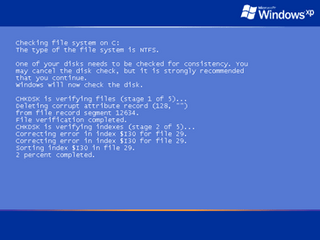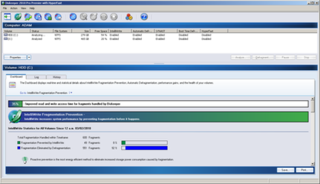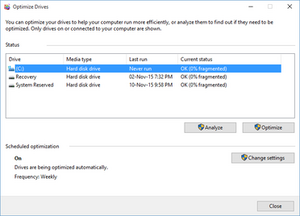NT File System (NTFS) is a proprietary journaling file system developed by Microsoft in the 1990s.
In the maintenance of file systems, defragmentation is a process that reduces the degree of fragmentation. It does this by physically organizing the contents of the mass storage device used to store files into the smallest number of contiguous regions. It also attempts to create larger regions of free space using compaction to impede the return of fragmentation. Some defragmentation utilities try to keep smaller files within a single directory together, as they are often accessed in sequence.

Norton Utilities is a utility software suite designed to help analyze, configure, optimize and maintain a computer. The latest version of the original series of Norton Utilities is Norton Utilities 16 for Windows XP/Vista/7/8, released 26 October 2012.
PageDefrag is a program, developed by Sysinternals, for Microsoft Windows that runs at start-up to defragment the virtual memory page file, the registry files and the Event Viewer's logs.

In computing, CHKDSK is a system tool and command in DOS and Microsoft Windows, as well as Digital Research FlexOS, IBM/Toshiba 4690 OS, IBM OS/2. It verifies the integrity of the file system on a volume and attempts to fix logical file system errors. Logical errors are typically defined as software-level problems with a filesystem as a result of prior software malfunction or irregular use. Logical errors are contrasted with and usually less severe than hardware-level errors, which can not be fixed with CHKDSK and may instead require data recovery software or expert assistance. CHKDSK is similar to the fsck command in Unix and similar to Microsoft ScanDisk, which co-existed with CHKDSK in Windows 9x and MS-DOS 6.x.

Diskeeper is a discontinued defragmentation app, designed for Microsoft Windows. It was developed by Executive Software International, Inc., which later changed its name to Diskeeper Corporation, and is now called Condusiv Technologies. The final version of Diskeeper was released in March 2020. All of Diskeeper's features and functionality are now included in Condusiv's data performance software DymaxIO.
The Prefetcher is a component of Microsoft Windows which was introduced in Windows XP. It is a component of the Memory Manager that can speed up the Windows boot process and shorten the amount of time it takes to start up programs. It accomplishes this by caching files that are needed by an application to RAM as the application is launched, thus consolidating disk reads and reducing disk seeks. This feature was covered by US patent 6,633,968.
Contig is a command line defragmentation utility for Windows developed by Microsoft as part of the Sysinternals Suite.

In computing, file system fragmentation, sometimes called file system aging, is the tendency of a file system to lay out the contents of files non-continuously to allow in-place modification of their contents. It is a special case of data fragmentation. File system fragmentation negatively impacts seek time in spinning storage media, which is known to hinder throughput. Fragmentation can be remedied by re-organizing files and free space back into contiguous areas, a process called defragmentation.
NTBackup is the first built-in backup utility of the Windows NT family. It was introduced with Windows NT 3.51. NTBackup comprises a GUI (wizard-style) and a command-line utility to create, customize, and manage backups. It takes advantage of Shadow Copy and Task Scheduler. NTBackup stores backups in the BKF file format on external sources, e.g., floppy disks, hard drives, tape drives, and Zip drives. When used with tape drives, NTBackup uses the Microsoft Tape Format (MTF), which is also used by BackupAssist, Backup Exec, and Veeam Backup & Replication and is compatible with BKF.
Windows Vista contains a range of new technologies and features that are intended to help network administrators and power users better manage their systems. Notable changes include a complete replacement of both the Windows Setup and the Windows startup processes, completely rewritten deployment mechanisms, new diagnostic and health monitoring tools such as random access memory diagnostic program, support for per-application Remote Desktop sessions, a completely new Task Scheduler, and a range of new Group Policy settings covering many of the features new to Windows Vista. Subsystem for UNIX Applications, which provides a POSIX-compatible environment is also introduced.
Condusiv Technologies is an American software company based in Burbank, California. The company was formerly known as Diskeeper Corporation, a name derived from its flagship product, Diskeeper, a file-system defragmentation software package for Microsoft Windows and OpenVMS. Before adopting the Diskeeper name, the company was known as Executive Software International, Inc.

O&O Defrag is a Windows defragmentation utility sold by German software developer O&O Software. It has won several awards by PC journals and magazines, and is certified by Microsoft for all its current NTFS-based operating systems, including NT 4.0, 2000, XP, Vista, 7, 8, 8.1, 10, 11, Server 2003, 2008, 2008 R2, 2012, 2012 R2, 2016, 2019 and 2022.

Vopt is a Windows defragmentation utility sold by Golden Bow Systems. It is one of the oldest defragmentation products, and has supported MS-DOS and all versions of Microsoft Windows. The convenience of quick processing time is offset by less optimal performance, but when used in conjunction with the built-in optimization of the Windows prefetch folder, system performance is maintained without major reorganization of all the files on the drive.

Defraggler is a freemium defragmentation utility developed by Piriform Software, which can defragment individual files or groups of files on computer memory systems. Defraggler runs on Microsoft Windows; it has support for all versions since Windows XP. It includes support for both IA-32 and x64 versions of these operating systems.

UltraDefrag is a disk defragmentation utility for Microsoft Windows. Prior to version 8.0.0 it was released under the GNU General Public License. The only other Windows-based defragmentation utility licensed under the GNU GPL was JkDefrag, discontinued in 2008.

JkDefrag is a free open-source disk defragmenting utility computer program for Windows. It was developed by Jeroen Kessels beginning in 2004 and was released under the GNU General Public License. Since version 4 of 2008, much changed from previous versions, JkDefrag was renamed MyDefrag by its developer; earlier JkDefrag versions continued to be available. MyDefrag, which was closed source freeware, was discontinued, with the last version being v4.3.1, file date 21 May 2010; for several years the MyDefrag website has been a redirect to the still-existing JkDefrag site, but links to downloadable JKdefrag files are dead. JkDefrag source code is still available from third-party websites
UltimateDefrag is a retail file-system defragmentation utility made by DiskTrix. An older version of the program is available as the UltimateDefrag Freeware Edition.
The following is a comparison of notable file system defragmentation software:
PerfectDisk is a defragmentation software product for Windows developed by Raxco.







